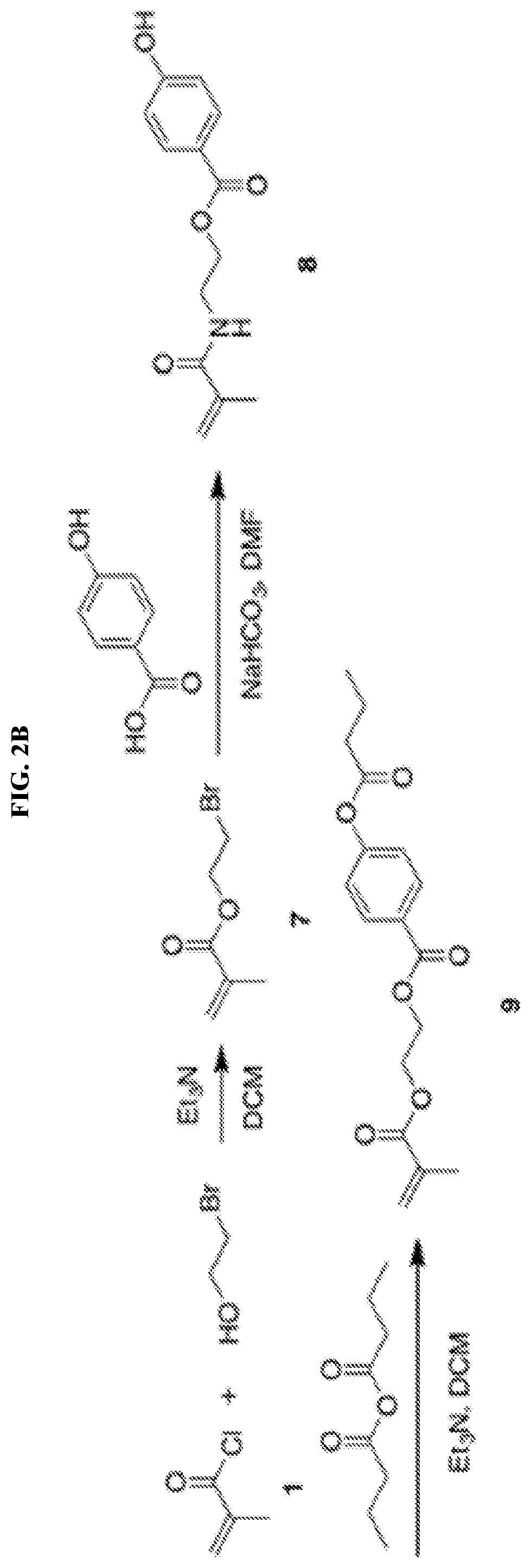Polymer materials for delivery of short chain fatty acids to the intestine for applications in human health and treatment of disease
a technology of short-chain fatty acids and polymer materials, which is applied in the field of polymer materials, can solve the problems of malodorous, upsetting the stomach, and challenging the translation of short-chain fatty acid treatments to clinical use, and achieves the effects of not widely used, difficult to detect, and difficult to diges
- Summary
- Abstract
- Description
- Claims
- Application Information
AI Technical Summary
Benefits of technology
Problems solved by technology
Method used
Image
Examples
example 1
on of N-(2-hydroxyethyl) Methacrylamide Monomers with Pharmaceutically-Active Small Molecules
[0108]Ethanolamine (3.70 mL, 61.4 mmol, 2.0 eq), triethylamine (4.72 mL, 33.8 mmol, 1.1 eq) and 50 mL DCM were added into a 250 mL flask. After the system was cooled down by an ice bath, (1) methacryloyl chloride (3.00 mL, 30.7 mmol, 1.0 eq) was added dropwise under the protection of nitrogen. The reaction was allowed to warm up to room temperature and reacted overnight. Then the reaction mixture was concentrated by rotary evaporation and purified on a silica column using DCM / MeOH. The product N-(2-hydroxyethyl) methacrylamide (2) was obtained as colorless oil (3.42 g, 86.3%) and analyzed by 1H-NMR (500 MHz, CDCl3) δH ppm 1.93 (s, 3H, C(CH2)—CH3), 3.43 (m, 2H, NH— CH2), 3.71 (m, 2H, O—CH2), 5.32 (s, 1H, CCH2), 5.70 (s, 1H, CCH2), 6.44 (br s, 1H, NH).
[0109]N-(2-hydroxyethyl) methacrylamide (3.30 mL, 25.6 mmol, 1.0 eq), triethylamine (7.15 mL, 51.2 mmol, 2.0 eq) and 50 mL DCM were added into a...
example 2a
n of Block Copolymers of Hydrophilic Polymers with N-(2-hydroxyethyl Methyacrylamide
[0110]pHPMA was prepared using 2-cyano-2-propyl benzodithioate as the RAFT chain transfer agent and 2,2′-Azobis(2-methylpropionitrile) (AIBN) as the initiator. Briefly, HPMA (4) (1.0 g, 7.0 mmol, 1.0 eq), 2-cyano-2-propyl benzodithioate (15 mg, 0.07 mmol, 1 / 100 eq), and AIBN (2.9 mg, 0.017 mmol, 1 / 400 eq) were dissolved in 2.0 mL MeOH in a Schlenk tube. The reaction mixture was subjected to four freeze-pump-thaw cycles. The polymerization was conducted at 70° C. for 15 h. The polymer was precipitated in petroleum ether for five times and dried in the vacuum chamber overnight. The product poly(HPMA) (5) was obtained as light pink solid (0.79 g, 79%) and analyzed by 1H-NMR (500 MHz, DMSO-d6), δH ppm 0.8-1.2 (m, 6H, CH(OH)—CH3 and backbone CH3), 1.5-1.8 (m, 2H, backbone CH2), 2.91 (m, 2H, NH—CH2), 3.68 (m, 1H, C(OH)—H), 4.70 (m, 1H, CH—OH), 7.18 (m, 1H, NH).
[0111]The block copolymer was prepared using p...
example 2b
n of 2-(4-hydroxybenzoyloxy)ethyl Methacrylate Monomers with Pharmaceutically-Active Small Molecules
[0112]2-Bromoethanol (4.36 mL, 61.5 mmol, 1.5 eq), triethylamine (9.15 mL, 65.6 mmol, 1.6 eq) and 60 mL DCM were added into a 250 mL flask. After the system was cooled down by an ice bath, (1) methacryloyl chloride (4.00 mL, 41.0 mmol, 1.0 eq) was added dropwise under the protection of nitrogen. The reaction was allowed to warm up to room temperature and reacted overnight. Then the reaction mixture was concentrated by rotary evaporation and purified on a silica column using DCM / MeOH. The product 2-bromoethyl methacrylate (7) was obtained as colorless oil (6.62 g, 84.1%) and analyzed by 1H-NMR (500 MHz, CDCl3) δH ppm 1.95 (s, 3H, C(CH2)—CH3), 3.57 (m, 2H, Br—CH2), 4.45 (m, 2H, O—CH2), 5.62 (s, 1H, CCH2), 6.18 (s, 1H, CCH2). 4-Hydroxybenzoic acid (2.00 g, 14.5 mmol, 1.2 eq), sodium bicarbonate (2.94 g, 35.0 mmol, 2.9 eq) and 20 mL DMF were added into a two-armed flask. The mixture was r...
PUM
| Property | Measurement | Unit |
|---|---|---|
| wt % | aaaaa | aaaaa |
| molecular weight | aaaaa | aaaaa |
| molecular weight | aaaaa | aaaaa |
Abstract
Description
Claims
Application Information
 Login to View More
Login to View More - R&D
- Intellectual Property
- Life Sciences
- Materials
- Tech Scout
- Unparalleled Data Quality
- Higher Quality Content
- 60% Fewer Hallucinations
Browse by: Latest US Patents, China's latest patents, Technical Efficacy Thesaurus, Application Domain, Technology Topic, Popular Technical Reports.
© 2025 PatSnap. All rights reserved.Legal|Privacy policy|Modern Slavery Act Transparency Statement|Sitemap|About US| Contact US: help@patsnap.com



